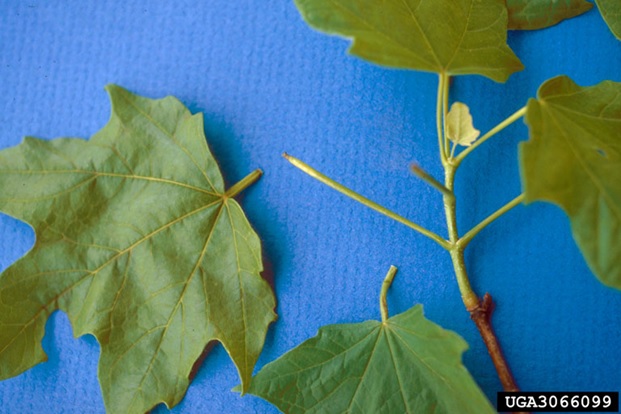Maple Petiole Borer
ENTFACT-405: Maple Petiole Borer | Download PDF
by jonathan l. Larson, Extension Entomologist
University of Kentucky College of Agriculture
Fast Facts
- Maple petiole borer is an introduced sawfly species that can induce premature leaf drop in maples, most often sugar maples.
- As a larva, they feed inside the leaf petiole, as a result about a third of a tree’s leaf canopy may suddenly drop to the ground in May or June.
- The tree can outgrow this issue over the remainder of the season and there are no effective controls to implement against this insect.
Potential Hosts
Maple petiole borers are maple pests. They can be found in any species of maple but are most common in sugar maples.
Symptoms and Pest Description
The most obvious symptom is premature leaf drop in late May or early June. Seemingly overnight, a sugar maple may suddenly lose 20-30% of its canopy. The fallen leaves will have short and stubby “stems”, the petiole will have snapped due to the boring and feeding of larvae inside. The rest of the petiole will be found in the tree. This would be different than the long petioles expected on fallen leaves from a storm or wildlife.

Before leaf drop, the leaves may also exhibit scorched or wilted symptoms as the larva feeds in the petiole.
Adult petiole borers are sawflies, small stingless wasps. They are around a quarter inch long and dark in color, they would be rarely seen. The larvae in the stems are also small but are cream colored.
Life Cycle in Kentucky
There is one generation per year. They overwinter in the soil near trees as a pupa. In the spring, adults will emerge and mate, then lay eggs in petioles. After hatching, the larvae feed for about a month before the leaves will drop. After leaf drop, the larvae remain in the petiole still in the tree for about ten days before both fall to the ground. The larvae then emerge, dig into the soil and pupate.
Management
Management is not necessary for this insect. Trees that are infested can rebound from the damage and there are no insecticidal options. Raking up fallen leaves is also not effective as the larvae are not in that portion of the petiole.
05/25 (Revised)
CAUTION! Pesticide recommendations in this publication are registered for use in Kentucky, USA ONLY! The use of some products may not be legal in your state or country. Please check with your local county agent or regulatory official before using any pesticide mentioned in this publication.
Of course, ALWAYS READ AND FOLLOW LABEL DIRECTIONS FOR SAFE USE OF ANY PESTICIDE!
Images: University of Kentucky Entomology.
